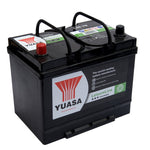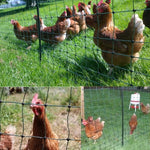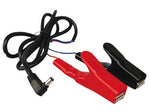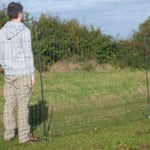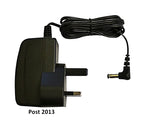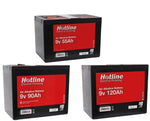You have no items in your shopping cart.
Electric Fencing Mistakes
With 30 years of experience building hundreds of miles of electric fences, I've seen just about every fencing mistake possible. I continue to see people make many of the same common mistakes. With a little commitment and a modest investment in time to learn how to use this new technology, you can save pounds and hours of maintenance time by making electric fencing work for you. Keep it simple and you wont go wrong. So you won't have to learn the hard way, here are common mistakes that you should avoid:
Poor earth grounding.
Many people still think you can skimp when it comes to adequate earth grounding. What we must all learn to do, is install several ground rods -- at least three, Copper or galvanised, and attached with good ground clamps. Place these rods in areas where the soil is likely to be damp, under a dripping tap, building eaves or flower bed. The electricity must complete a full circle back to the charger through the ground. Poor grounding gives weak shocks.
Inadequate charger.
A wimpy fence energiser gives you a wimpy fence. Don't skimp here because animals will think an Electric Fence is a joke without a strong bite, and they'll walk right through it. The fence itself does not keep the animal in - it is the electronic bite in the fence that does the work. Please buy one that puts out lots of power. During a rainy year, you may have lots of plant growth touching the wires. That's when you will need extra power to push through the heavy, wet vegetation. The cost of the energiser does NOT rise in direct correlation to the power output, more powerful energisers are substantially cheaper per unit of energy than low power sources.
Inadequate animal training.
Each and every animal must learn that the fence hurts. Rather than force the animal to try and cross the fence, try feeding it under the fence so that it comes into contact with the fence. The best method to introduce a fence is to attach some bait to the fence. The animal does not associate the fence with its food but does associate the pain directly with the fence.
Fence posts too close together.
Posts may be anything up to 15 meters apart. Putting them 3 m apart is not necessary. Posts must follow the terrain and simply keep the wire at a uniform distance off the ground without too much sag. You want the fence to act like a rubber band. When something runs into the wire, you don't want to break all the insulators or knock posts out of the ground. If the posts are spread apart the wire will just bend to the ground and pop back up.
Too many wire tie-offs.
Again, fencing specifications may call for braces every quarter mile wire to tie the wire off. But I have found that even 5,000 feet is OK, and actually adds more elasticity in the fence wire. This reduces the chance of wires breaking.
Wires tied tight to each fencepost. To maintain elasticity (the rubber band effect), wires must float past each line fencepost. Often tape is locked into insulators on every post to restrict wind flap but this then causes a lack of elasticity on the wire.
Building new fences near old existing fences.
Old fence wires seem to be always moving somewhere and coming in contact with the new electrified wires. This almost always causes a complete short in the fence, and away the animals go.
Bottom wire in contact with wet vegetation
Wet grass will suck lots of juice out of any fence charger. Attach the lower wires to the live terminal of the energiser separately from the other wires, and install a switch for the lower wires that you can turn them off when the grass is tall.
Poor-quality insulators.
Be careful here. Sunlight deteriorates plastic. So buy good-quality, long-lasting insulators. Usually black ones are treated to resist degradation by ultraviolet light. I have found that poor quality insulators crack after a few years in direct sunlight.
Solar panels not directly facing the sun.
This seems almost too obvious to be a problem. But a solar panel won't function at its potential if not properly installed. Please read the instructions. Don't just guess if you have done it right.
Kinks in high-tensile wire.
A small kink in stiff wire will always break. Also avoid hitting this kind of wire with a hammer, as this will easily damage the wire causing a break. Always cut out a damaged section of high tensile wire and splice it. Incidentally, I have found that a hand-tied reef knot makes the strongest splice.
Installing in-line strainers close together.
Wires will flip together once in awhile. If in-line strainers are installed one above the other, they will sometimes hook up. Separate in-line strainers by a fence post and they will never catch on each other. Wires too close to each other. Keep them at least 5 inch apart.
Wire stretched too tight.
Electric Fences do not have to be tightly strained. Use inline-strainers that pull just enough to get the sag out of the wire between the fence posts.
No voltmeter
Without a voltage meter to check how hot a fence is, you're just guessing. The only other way is to use your hand - that hurts.
Wire too small.
The better the conductor in the wire, the more electricity it will carry. Don't skimp. Conductors are measured in Ohms per Meter - the lower this figure the better it is
The next time your bulls get in a fight with the neighbours bulls and tear down the entire fence, remember that most animals will learn not to touch a wire with 5,000 volts running thorough it.

